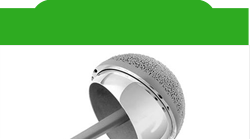Women and Hip Resurfacing
This is an important topic that has come to light recently in the national media (NY Times Nov 8, 2008). It is becoming increasingly evident that women have poorer results with hip resurfacing than men, in looking at results from around the world. I believe this has a few reasons and is largely due to the fact that a hip resurfacing depends upon the quality and amount of bone supporting the implants, particularly on the femoral head side. One can think of the bone as a foundation that supports the femoral head implant.
First of all, women tend to have lower bone density than men. Because of this fact, a resurfacing implant in a woman will be resting on lower density bone than in a man. At present, we don't have guidelines that tell us what a safe level of bone density is. With research studies looking forward, we may be able to use bone density tests preoperatively to help predict the success of the operation. At times, I use a DEXA bone density test to help gauge the strength of the bone in the femoral neck area. In general, if there is osteoporosis present, in a man or a woman, I don't recommend hip resurfacing.
Furthermore, women have hormonal fluctuations in their lives that may affect bone density. We do know that bone density further decreases after menopause. But we don't know the effect that this may have on a previously placed hip resurfacing implant. However, it could potentially lead to problems if the bone under the implant gets weaker with age.
Secondly, women tend to be smaller-boned than men. This translates to a smaller size implant; as stated before, this would lead to a smaller foundation to support the resurfacing head. There is also literature (De Haan et al, JBJS Britsh, 2008) suggesting that smaller implants may be more sensitive to positioning, thus making surgical placement of critical importance.
Thirdly, women tend to be more prone to allergies than men. Although allergy (hypersensitivity) to the metals is not a large cause of hip resurfacing failures, it seems to be more prevalent in women.
Thus, all of these factors may contribute to a higher failure rate of hip resurfacing in women compared to men.
Critical analysis of the literature
If one looks at the actual numbers reported in the worldwide literature, women have had a higher revision rate after hip resurfacing than in men. In the 2008 Australian Hip Registry (www.dmac.adelaide.edu.au/aoanjrr/documents/aoanjrrreport_2008.pdf), which examines the entire experience in Australia year after year, there was a significant difference in the revision rate of hip resurfacing between men and women at all timepoints. At 1 year, the revision rate was 2.1% in women and 1.6% in men; at 3 years, it was 4.0% vs. 2.1%. This difference was more pronounced in women over the age of 55.
In a British study entitled "Revision rates after Primary Hip and Knee Replacements between 2003 and 2006" (www.pubmedcentral.nih.gov/articlerender.fcgi?tool=pubmed&pubmedid=18767900), there was also a significant difference in the results of hip resurfacing in women and men. At 3 years, there was a 3.7% revision rate for women, and 1.9% in men. However, there was no analysis by age.
Finally, a recently published US study entitled "Initial American Experience with Hip Resurfacing following FDA approval" also found a higher short-term revision rate in women. However, this included the learning curve of 89 surgeons implanting their first hip resurfacings.
Conclusion
Given these facts, I believe that hip resurfacing should be used more carefully in women. There is a narrower window in selecting women as patients, because of the issues of child-bearing earlier in life, and bone density later in life. But I do think that hip resurfacing can have as successful results in women as in men, and I continue to perform it regularly.
The Center for Hip Pain & Preservation
541 East 71st Street
New York, NY 10021
 Click here for Driving Directions
Click here for Driving Directions

















